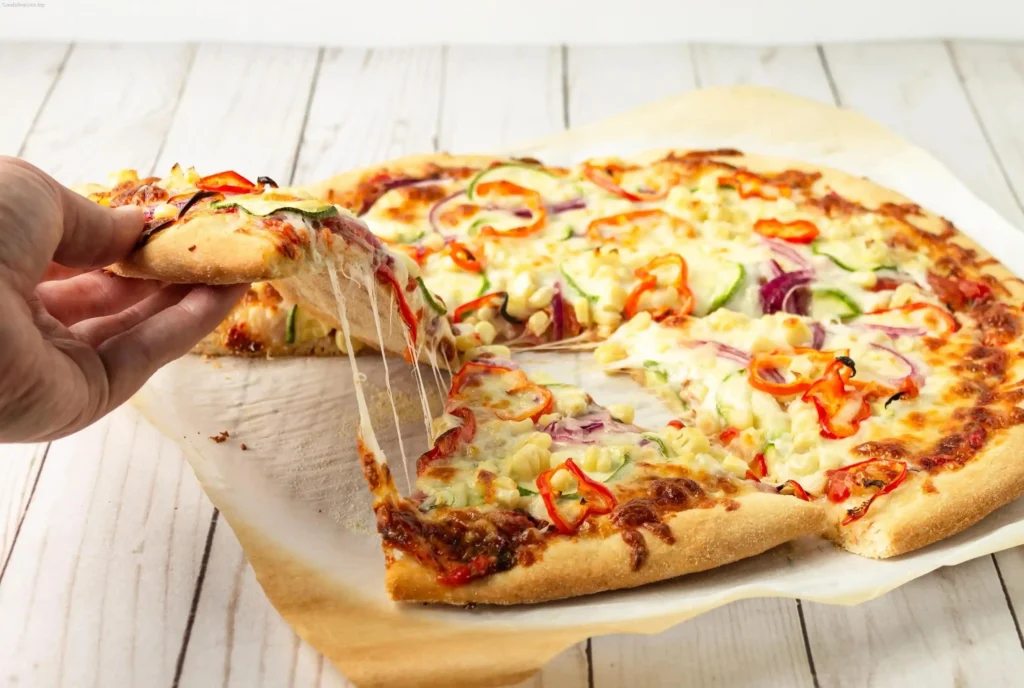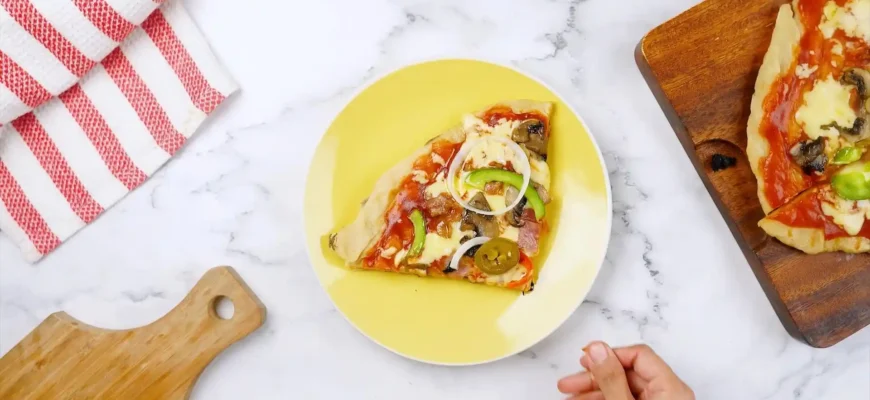Making pizza at home—now that’s a topic close to my heart. Whether you’re an experienced chef, a casual home cook, or just someone who loves the smell of pizza wafting through the kitchen, learning to make pizza from scratch is a rewarding experience. And I can tell you, it’s easier than you might think. Sure, you could grab a frozen pizza from the store, but there’s something special about creating your own masterpiece with fresh ingredients. The beauty of homemade pizza lies not just in the taste, but in the entire process—watching dough rise, smelling the tomato sauce simmer, and customizing every topping to suit your own taste.
I’ll walk you through the entire process, offering tips, addressing common mistakes, and pointing out potential pitfalls. And yes, I’ll make sure you get a little dose of humor, because who doesn’t love a little fun while cooking? So, roll up your sleeves, grab your apron, and let’s get into it!
Step 1: The Dough—The Heart of Your Pizza
First, let’s talk about the dough. The dough is, without a doubt, the heart of your pizza. Without a good base, even the finest toppings won’t save you. Luckily, making pizza dough at home is simple and doesn’t require any fancy ingredients.
Ingredients for the Dough:
- 500g (about 4 cups) all-purpose flour
- 325ml (1 1/3 cups) lukewarm water
- 7g (1 packet) active dry yeast
- 1 tsp sugar
- 1 tsp salt
- 2 tbsp olive oil
How to Make Pizza Dough:
- Activate the Yeast: In a small bowl, mix the warm water, sugar, and yeast. Stir gently and let it sit for about 5 minutes until the mixture gets bubbly and foamy. This is called “proofing” the yeast. If your yeast doesn’t foam, it might be expired or the water was too hot or cold—start again.
- Mix the Ingredients: In a large mixing bowl, combine the flour and salt. Make a well in the center and pour in the yeast mixture along with the olive oil.
- Form the Dough: Mix until a dough forms, and then knead it on a lightly floured surface for 8-10 minutes until it’s smooth and elastic. Don’t rush this step—this is where you develop that perfect pizza dough texture.
- Let it Rise: Place your dough in a lightly oiled bowl, cover it with a damp cloth or plastic wrap, and let it rise in a warm spot for about 1-2 hours, or until it doubles in size. This is the part where the magic happens.
- Punch Down and Shape: Once the dough has risen, punch it down to release the air. Divide it into two portions if you’re making smaller pizzas, or keep it whole for a large pizza. Roll it out into a round shape on a floured surface. You can make it as thin or thick as you like, but remember: a thinner crust tends to bake better and get crispier.

Common Pitfalls and Solutions:
- Dough Too Sticky: If the dough is too sticky to handle, simply add a bit more flour, one tablespoon at a time, until you get a workable dough.
- Dough Too Dry: If your dough feels too dry, add a tiny bit of water, but do so slowly to avoid making it too wet.
- Not Rising Properly: Ensure your kitchen is warm enough for the dough to rise. If it’s cold, try putting the bowl in a slightly warmed oven (turn it off after it heats up) to give your dough a little extra help.
Step 2: The Sauce—A Tomato Symphony
The sauce is what brings the pizza to life. While some people might go for store-bought sauce, homemade tomato sauce is a whole new level of flavor. It’s super easy to make, and you can customize it based on your taste preferences.
Ingredients for the Sauce:
- 1 can (400g) of crushed tomatoes
- 2 tbsp olive oil
- 2 garlic cloves, minced
- 1 tsp dried oregano
- 1 tsp dried basil
- Salt and pepper to taste
How to Make Pizza Sauce:
- Heat the Olive Oil: In a saucepan, heat the olive oil over medium heat. Add the minced garlic and cook for 1-2 minutes until fragrant, being careful not to burn it.
- Add the Tomatoes and Seasonings: Add the crushed tomatoes, oregano, basil, salt, and pepper. Stir to combine, then simmer the sauce for about 15-20 minutes, stirring occasionally. This allows the flavors to meld together.
- Blend (Optional): If you prefer a smoother sauce, you can use an immersion blender or regular blender to puree the sauce to your desired consistency. Some people like a chunkier sauce, while others prefer it silky smooth.

Common Pitfalls and Solutions:
- Too Acidic: If your tomato sauce tastes too acidic, add a pinch of sugar to balance the flavors.
- Too Thin: If your sauce is too watery, let it simmer a bit longer to reduce the liquid. It should be thick enough to spread easily without running off the dough.
Step 3: Toppings—The Fun Part!
Now, this is where you get to have fun and make the pizza your own. The possibilities are endless—whether you like traditional Margherita, pepperoni, or something more exotic like goat cheese and arugula, you’re in charge.
Popular Toppings:
- Cheese: The classic mozzarella is a must for any pizza, but you can mix it up with provolone, parmesan, cheddar, or goat cheese.
- Meats: Pepperoni, sausage, bacon, or even grilled chicken work well. Just make sure any meats you use are cooked through.
- Vegetables: Fresh tomatoes, mushrooms, bell peppers, onions, spinach, arugula—your options are endless. Just make sure to slice vegetables thinly so they cook evenly.
- Extras: Olives, artichokes, anchovies, or even pineapple (don’t get me started on pineapple, but hey, it’s your pizza).
Common Pitfalls and Solutions:
- Too Many Toppings: You can get carried away with toppings, but too much can overwhelm the dough and make the pizza soggy. Keep it balanced.
- Uneven Cheese Melting: If your cheese isn’t melting evenly, it might be too cold. Let your cheese come to room temperature before adding it to the pizza.
Step 4: Baking the Pizza—Getting it Just Right
Now that your pizza is topped, it’s time to bake it. To get that crispy, golden crust, you’ll need high heat and a little patience.
How to Bake Your Pizza:

- Preheat the Oven: Preheat your oven to the highest setting possible, usually around 250°C (475°F) or even higher if your oven allows. The hotter, the better. Some pizza aficionados even recommend preheating a pizza stone for an extra crispy crust.
- Bake the Pizza: Carefully slide your pizza onto the preheated oven rack or a baking sheet, and bake it for about 10-12 minutes or until the crust is golden brown and the cheese is bubbly and melted. Keep an eye on it—every oven behaves a little differently.
- Cool and Slice: Once baked, let the pizza cool for a few minutes before slicing. This helps the cheese set a bit so you don’t end up with a mess when cutting.
Common Pitfalls and Solutions:
- Burnt Crust: If your crust is browning too quickly but the toppings aren’t done, lower the oven temperature slightly and keep baking until everything is cooked through.
- Soggy Pizza: If your pizza is soggy, it could be due to too much sauce or wet toppings. Try draining excess moisture from veggies and use a slotted spoon for your sauce.
Conclusion: Pizza Making Is Both an Art and a Science
Making pizza at home is truly a rewarding experience. Sure, it’s an art—you get to express yourself with the toppings, shapes, and flavors—but there’s also a science behind it: getting the dough just right, baking at the perfect temperature, and balancing flavors. Once you master these basics, you can tweak and adjust to your heart’s content.
Real People, Real Opinions
To wrap things up, I asked a few people from different backgrounds about their thoughts on making pizza at home. Here’s what they had to say:
- Sophia, 29, Italy: “Pizza is my favorite food, and I make it every weekend. The dough is the most important part for me. If it’s too thick, I’m disappointed. My advice? Don’t rush the dough—it’s worth the wait.”
- John, 50, USA: “I’ve been making pizza for years, and my kids love when we make it together. I always tell them, the secret is in the sauce. Simmer it slowly to bring out all the flavors. Don’t settle for store-bought.”
- Maria, 43, Spain: “Making pizza at home is therapeutic. I like experimenting with different toppings, but I’ve learned not to overdo it. A simple Margherita is often the best.”
- Akira, 60, Japan: “I love the Italian way of pizza, but I add my twist—sometimes I use teriyaki chicken or miso paste as a base









